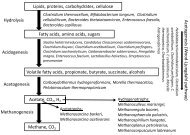Zymomonas mobilis - Biotechnology for Biofuels
Zymomonas mobilis - Biotechnology for Biofuels
Zymomonas mobilis - Biotechnology for Biofuels
You also want an ePaper? Increase the reach of your titles
YUMPU automatically turns print PDFs into web optimized ePapers that Google loves.
He et al. <strong>Biotechnology</strong> <strong>for</strong> <strong>Biofuels</strong> 2012, 5:75 Page 8 of 10<br />
http://www.biotechnology<strong>for</strong>biofuels.com/content/5/1/75<br />
such as gnl (ZMO1649), gntK (ZMO1757) and ZMO0899<br />
(see Additional file 1: Table S2).<br />
Induction of plasmid encoding genes under ethanol<br />
stress<br />
Interestingly, 30 genes from ZM4 plasmids were shown to<br />
be more abundant (1.0-2.7 fold, based on log2 system)<br />
under ethanol stress condition. However, most of these<br />
genes encode hypothetical proteins, such as pzmob1_p05,<br />
pzmob1_p06, pzmob1_p07, ZZM4_0013, ZZM4_0026,<br />
ZZM4_0027, ZZM4_0114. Especially, pzmob1_p05,<br />
pzmob1_p18 and pzmob1_p19 should the same profling<br />
between furfural and etanol stress [32].<br />
Five plasmid encoding genes showed less abundant<br />
under the same condition (1–1.4 fold, based on log 2 system),<br />
such as ZZM4_0002, ZZM4_0006, ZZM4_0121,<br />
ZZM4_0154 and ZZM4_0156 (see Additional file 1:<br />
Table S1 and Table S2). However, pzmob1_p06 and<br />
pzmob1_p07 showed more abundant under furfural<br />
stress, and less abundant during 5% ethanol condition. It<br />
may be indicated that different plasmid encoding genes<br />
are responsible to different stress. Furthermore, the<br />
function of plasmid encoding genes are still unclear, and<br />
further work should be focing on these genes.<br />
Conclusion<br />
In this study, we successfully identified genes involved in<br />
ethanol tolerance by microarray analysis. These genes<br />
were classified as being involved in a wide range of cellular<br />
processes including carbohydrate metabolism, cell<br />
wall/membrane biogenesis, respiratory chain, terpenoid<br />
biosynthesis, DNA replication, DNA recombination,<br />
DNA repair, transport, transcriptional regulation, some<br />
universal stress response, etc. Our study indicated that<br />
ethanol tolerance in Z. <strong>mobilis</strong> is affected by various<br />
complicated processes that take place on both the molecular<br />
and the cellular level, and that membrane might<br />
play important roles in response to ethanol. Although<br />
the molecular mechanism involved in tolerance and<br />
adaptation of ethanologenic strains to ethanol is still unclear,<br />
this research has provided insights into molecular<br />
response to ethanol in Z. <strong>mobilis</strong>. These data will also be<br />
helpful to construct more ethanol resistant strains <strong>for</strong><br />
cellulosic ethanol production in the future.<br />
Material and methods<br />
Bacterial strains and fermentation conditions<br />
Z. <strong>mobilis</strong> ZM4 (ATCC31821) was cultured in Rich<br />
media (RM) [51] at 30°C without shaking. Cultures were<br />
maintained on glucose agar (20.0 g/l glucose, 10.0 g/l<br />
yeast extract and 15.0 g/l agar). Organism was subcultured<br />
to fresh inoculum media <strong>for</strong> 24 h at 30°C be<strong>for</strong>e<br />
being inoculated into the fermentation medium. Inoculum<br />
medium (g/l) consisted of 10.0 g yeast extract, 1.0 g<br />
MgCl2, 1.0 g (NH4)2SO4, 1.0 g KH2PO4, 20.0 g glucose.<br />
The final concentration of ethanol was set up at 5% (v/v)<br />
<strong>for</strong> the study of the response of ethanol stress in Z.<br />
<strong>mobilis</strong>. The optical density was measured with a spectrophotometer<br />
at 600 nm with an initial OD 600 of 0.05<br />
when the inoculum was added to each flask (with or<br />
without 5% ethanol).<br />
Cell growth and glucose analysis<br />
Cell growth was determined by monitoring the optical<br />
density at 600 nm by using Multi Scanner Spectrometer<br />
(Thermo Inc.) at 4-h intervals. Fermentation supernatant<br />
was prepared by passing through 0.2 μm membrane<br />
(Millipore) and used to determine the concentrations of<br />
glucose. Ions Chromatography (Switzerland, Metrohm<br />
Bio-Scan 871) was applied to measure the concentration<br />
of glucose with sodium hydroxide (0.1 M) as mobile phase<br />
at a flow rate of 1.0 ml/min as described previously [32].<br />
RNA isolation, fluorescein-labeled Cdna and microarray<br />
Total RNA was isolated essentially described previously<br />
[32,52]. The RNA quality was assessed by <strong>for</strong>maldehyde<br />
agarose gel electrophoresis and quantitated at OD 260<br />
and OD 280 by spectrophotometer, respectively. The purified<br />
RNA from each sample was used as the template to<br />
generate cDNAs while labeled with either Cy3-dUTP or<br />
Cy5-dUTP (CapitalBio) in a duplicate set.<br />
Z. <strong>mobilis</strong> microarrays were constructed by CapitalBio<br />
Corporation (Beijing, China) using coding sequences<br />
predicted by The Institute <strong>for</strong> Genomic Research (TIGR,<br />
http://www.tigr.org/). Microarray hybridization, washing,<br />
scanning and data analysis were carried out according to<br />
the NimbleGen’s Expression user’s guide. Gene expression<br />
analysis was per<strong>for</strong>med using six independent<br />
microarray experiments (two dye reversal reactions ×<br />
three biological replicates) with each microarray containing<br />
one to two probes per predicted coding sequence<br />
each.<br />
Hierarchical clustering and comparison analysis were<br />
per<strong>for</strong>med by Cluster 3.0 and SAM 3.02 software, respectively.<br />
Sgnificantly differentially expressed genes<br />
were determined with a selection threshold of false discovery<br />
rate, FDR



